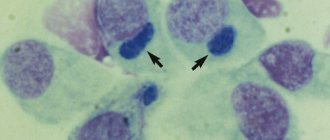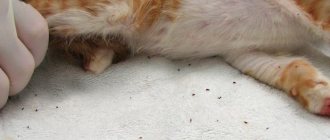Staphylococci are a genus of spherical bacteria that includes more than 50 species and countless strains. These are opportunistic microorganisms that live next to us all our lives. Even the “terrible” Staphylococcus aureus in cats peacefully coexists with the carrier up to a certain point.
It will not be possible to protect yourself and your pet from contact - these microbes live in food, soil and water, on the skin, mucous membranes, in the intestines, and urogenital tract. They do not need oxygen, are comfortable at high temperatures and tolerable at very high temperatures - they even survive in boiling water. Better than other bacteria, they tolerate freezing, drying, preservation, and disinfectants.
What to do in such a situation? To get started, we recommend reading this article. This article describes in detail methods of controlling parasites. We also recommend that you consult a specialist. Read the article >>>
The danger comes from species that produce toxins. If the immune system cannot cope with controlling the number of such bacteria, staphylococcus in the cat multiplies progressively. Every 20 minutes the number doubles, which means twice as many toxins and enzymes that destroy healthy cells.
Main pathogenic species:
| Types of staphylococci | Description |
| Hemolytic (haemolyticus) | Purulent inflammatory processes on the skin, mucous membranes, internal organs; |
| Epidermal (epidermidis) | Conjunctivitis, endocarditis, sepsis, wound infections, urinary tract infections, pneumonia; |
| Saprophytic (saprophyticus) | Inflammation of the bladder, urinary canal, endometritis, dermatitis, rhinitis; |
| Golden (aureus) | Endocarditis, pneumonia, meningitis, sepsis, toxic shock, abscesses. Staphylococcus aureus in cats is the most pathogenic species. |
Theoretically, you can become infected from a sick pet through prolonged contact, poor personal hygiene, or congenital predisposition. At risk are children, chronically ill people, and people with low immunity. A healthy adult must try very hard to become infected from a pet.
Causes
The main reasons for the development of the disease include:
- excessive amount of carbohydrates in the body;
- weakened immunity. In this situation, Staphylococcus aureus in cats is especially dangerous. With a weakened immune system, purulent lesions appear;
- endocrine system problems caused by hormonal disorders;
- lack of vitamins A, E, B;
- food poisoning;
- allergies, including those associated with the activity of parasites;
- diabetes.
Predisposing factors
These microorganisms are very unusual. In particular, for each animal species there are those strains that are specific to it. Thus, the most dangerous for domestic cats and dogs are St.aureus, St.epidermaticus, St.intermedium. There are some predisposing factors that significantly increase the risk of infection:
- Serious disorders of carbohydrate metabolism. This category includes not only diabetes, but also simply improper feeding. Simply put, if your cat eats only cereals and bread, nothing good can happen.
- Congenital and acquired immunodeficiencies, of course. Staphylococcus aureus is especially dangerous in this case: in cats, this microorganism causes severe purulent inflammations that are difficult to treat.
- Hormonal imbalances. As in the previous case, this applies mainly to old cats.
- Insufficient intake of vitamins. This especially applies to group B, as well as tocopherol and carotene.
- Staph infections are very common if your cat has recently been exposed to toxic substances. Simply put, poisoning opens the “gate” to the disease, weakening the immune system and worsening the general condition of the cat.
- Allergic reactions, dermatitis and eczema. Particularly susceptible to staphylococcosis are cats that suffer greatly from flea bites.
- Finally, we must not forget about the individual susceptibility of a particular animal.
Which breeds are most susceptible to infection?
Cats of any breed and even outbred cats, which are usually more resistant to any infections, are at risk of becoming infected with staphylococcus and subsequently falling ill. But still, the disease is more often diagnosed in hairless breeds, whose skin is less protected and more easily damaged. Bacteria penetrate through the scratches, and the lack of hair on the skin leads to hypothermia in animals. All this helps to reduce the animal’s resistance to the development of infection.
Long-haired cats, such as Persians, are no less likely to be infected. The nature of this breed is aggressive, and they are more likely than others to get into fights and receive wounds and scratches. The peculiarity of these animals, which have luxurious fur, is that staphylococcal infection is more severe in them.
Symptoms
The incubation period can vary: from several days to several weeks. At this time, the pet looks quite healthy and his health remains normal.
Then the general symptoms of staphylococcus in cats appear:
- temperature increase;
- apathy;
- thirst;
- weakness;
- refusal to eat.
Skin damage occurs - pyoderma. The animal suffers from severe itching. Small ulcers can be seen on the epidermis. These are the initial signs of staphylococcus in cats. Photos of the manifestations of the disease can be seen below.
If treatment is not carried out at the initial stage, pyoderma turns into weeping dermatitis. Areas of baldness appear, and liquid (exudate) with an unpleasant odor is released from the skin. Dermatitis is especially severe in overweight animals, in cats of long-haired breeds, as well as in pets infected with fleas and ticks.
Subsequently, the inflammatory process affects the hair follicles. Bubbles with purulent contents form on the skin. Due to severe itching, the cat becomes aggressive and irritable. The animal cannot eat or sleep normally.
If left untreated, pyoderma spreads to the deep areas of the epidermis and subcutaneous tissue. Boils form. The areas of baldness are increasing. You may notice crusts in your nose.
Staphylococcus in cats can affect not only the skin, but also other organs:
- Reproductive system. In females, inflammation of the vagina occurs, and then the infection enters the uterus. This leads to endometritis. The cat is bothered by pain in the lower abdomen and exudate is released from the genital tract. In cats, the foreskin becomes inflamed and pus comes out of the penis.
- Organ of hearing. Staphylococcus causes otitis media - inflammation of the middle ear. In this case, the cat often scratches its ears and shakes its head. Then pain occurs. The animal does not tolerate even light touches to the ears. The shells appear swollen and inflamed.
- Eyes. Very rarely, staphylococcus can affect the organ of vision. In this case, purulent conjunctivitis occurs in cats.
Why is staphylococcus dangerous?
Scientists and microbiologists have found that staphylococcus is pathogenic. A cat can have an infection since childhood, but not manifest its dangerous properties throughout the pet’s life.
. However, due to some factors that we will look at in the next section, the staphylococcus begins to work and kill the cat, manifesting more and more infectious diseases.
The infection is dangerous not only for pets, but also for people who come into contact with them
.
Also often the pet does not get sick, but the person becomes infected with staphylococcus . Infection occurs after direct contact with an animal, for example through scratches that were received accidentally while playing with a favorite animal, or simply by stroking a cat.
That is why, if you notice the first signs of illness in your pet or even in you, you should immediately contact a veterinarian or doctor, respectively. In the treatment of this disease, as in the treatment of many others, it is the time and the stage at which it was discovered that the disease exists that plays a big role.
However, staphylococcus can be transmitted through contact with an animal
, so you should not transport your cat to the veterinary center yourself. Our experienced YA-VET veterinarians can arrive in 40 minutes, conduct the necessary studies and analyzes and, based on them, make a conclusion and recommendations for recovery.
Causes
If you take care of the animal, feed it the right food and the pet is active and athletic, then the disease may not manifest itself; staphylococcus remains non-pathogenic and does not affect the cat’s health.
But if the factors that will be listed below appear, the disease may become more active. The bacterium comes to life, infects the pet’s body and puts it at risk of developing new infections.
- Veterinarians distinguish the following
factors that influence the development of staphylococcus
- in cats:
- Disorders of carbohydrate metabolism. For example, if you have diabetes or simply an unhealthy diet that does not contain the necessary vitamins and minerals for the animal to live a full life;
- Weak immunity. He can be weak either after an illness or simply from birth;
- Problems with hormonal levels due to the age of the cat or simply problems that appear in old animals;
- Toxicity after cat poisoning. If an animal is poisoned by something, then its body is greatly weakened and its condition worsens, which becomes the reason for the revival of staphylococcus;
- Various skin diseases, such as eczema, lichen and various dermatitis;
- Vitamin deficiency, which was already mentioned at the beginning, but it can be caused not only by poor nutrition, but by other factors.
There are no specific breeds in which the disease manifests itself more often or less frequently; the risk of becoming infected and getting sick is the same for everyone. However, the risk of getting sick is high in cats with long hair or, conversely, Persian breeds that are almost completely hairless. The risk of disease increases if cats walk outside. Also, the risk of contracting an infection increases after street fights. Wounds and scratches become inflamed and staphylococcus begins to work and poison the body.
Symptoms
Veterinarians identify the following symptoms and signs of illness in pets:
1Firstly, most often cats begin to develop skin diseases that are difficult to treat. Against the background of skin disease and dermatitis, pyoderma appears - a purulent lesion of the skin, which is caused by staphylococcus. First, irritations appear on the surface of the skin, which can itch and peel. When such a sign appears, you should contact a veterinarian, because if treatment is started, the disease may progress to a more serious stage. 2The disease begins its journey in the chest, submammary and area between the legs, and if left untreated, it expands and can manifest itself on the entire surface of the body, including the animal’s head. 3 Older cats (overweight) have a symptom that cannot be overlooked or confused. Spots begin to appear all over the body, which not only itch, but also secrete fluid and pus, and also have an unpleasant odor. 4 A cat that suffers from flea dermatitis runs the risk of aggravating the situation and the disease developing into pyoderma. If the disease is not treated, the inflammation will go deep inside the body and boils and various ulcers will begin to form, which will cause an increase in temperature in the animal and can also lead to death. 5Another sign that is characteristic of staphylococcus is disease of the genital organs of a cat. The cat develops purulent vaginitis, which can develop into the endometrium. In cats, the disease develops posthitis, which is characterized by ulcers on the genitals. Animals endure the disease incredibly hard and painfully, because these places provide a favorable environment for the accumulation of staphylococcus. 6 In animals, when staphylococcal microbes are activated, chronic otitis may occur, and sometimes serous or purulent conjunctivitis develops. For kittens, infection with staphylococcus is almost always a fatal disease. Staphylococcus causes severe diarrhea in kittens during the first week of life, which leads to rapid dehydration of the body, resulting in death from intoxication. 7 Pets may also develop otitis media, and in other cases, serious conjunctivitis may occur. The issue with kittens is even more complicated; most often the disease is especially dangerous and even fatal for them. In the first week, the disease causes them diarrhea and vomiting, which causes exhaustion and dehydration.
Complications
It is very important to promptly treat Staphylococcus aureus in cats. In advanced cases, bacterial disease can lead to sepsis. This complication is often called blood poisoning. In this case, bacteria constantly circulate in the plasma. Microorganism toxins accumulate in the blood, which have an extremely negative effect on the functioning of the heart and blood vessels. Blood poisoning often leads to septic shock and death of the animal.
Consequences of staphylococcus for cats
A serious consequence of staphylococcus infection for cats can be considered weeping dermatitis, which is difficult to treat with medications and brings a lot of suffering to the animal. Further progression of this disease contributes to a more widespread spread of pathology on the animal’s body, not excluding its head and muzzle. Kittens from dehydration caused by this disease in most cases do not survive and die in the first week of illness.
As a result of the development of Staphylococcus aureus, animals undergo changes in a variety of organs. Staphylococcus in a cat's ears leads to chronic forms of otitis and purulent conjunctivitis.
You can find symptoms that indicate Staphylococcus aureus in your cat's nose, with an erosive surface forming around the nose and mouth.
Adult cats are also often unable to get a staphylococcal infection as a result of infection of the body with pathogenic microbes. Their large accumulation leads to poisoning of the body with toxins released by microorganisms as a result of their existence. The development of septic shock is the main cause of death in animals of any age.
Can a cat infect a person?
Can a person become infected from a sick cat and what is the likelihood of this possibility - such questions are often asked at an appointment with a veterinarian.
Infection of a person by a cat with staphylococcus is quite acceptable, and this can happen in the following cases:
- contact method;
- nutritional;
- using the airborne method.
Most often, infection occurs during a bite, since even a small damage on the human skin left by the teeth of a sick animal will be enough for this. Infection is also possible if hygiene rules are not followed, since pathogenic microbes remain on the hands after playing with the cat or after cleaning its litter box.
It has been noted that most cases of infection from sick animals occur in the elderly and children. It is for this reason that in order to protect yourself and your loved ones from the possibility of infection with staphylococcus, it is necessary not only to wash your hands thoroughly, but also to be able to identify the disease at the initial stage by its first signs.
Diagnostics
If you suspect an infection or the development of an infection in cats, you must meet with a veterinarian and carry out the prescribed tests.
Since staphylococcal infection has a number of similar symptoms to other diseases, diagnosis includes the following:
- analysis of blood samples for bacterial culture;
- microscopic examination of scrapings from areas of skin with lesions;
- study of smears of discharge from the genital tract.
As a rule, a general blood test is not carried out in this case due to its lack of information, for the reason that changes in the blood from exposure to staphylococcus can only be detected in the stage of sepsis.
Consequences
The lack of competent treatment for such an infection is fraught with weeping dermatitis for the animal.
If not treated promptly, staph infections in cats can cause weeping dermatitis, which is quite difficult to cure. As the disease progresses, there is an increase in the size of the areas of the skin affected by the disease. Often staphylococcus causes posthitis, which is an inflammation of the foreskin. Sometimes chronic otitis media or purulent conjunctivitis may occur. The pathology poses the greatest danger to kittens. Almost all cases of infection end in the death of the pet. This is due to severe dehydration of the body. Death can also occur in older animals. This is due to blood poisoning.
Staphylococcus in cats and its symptoms
Staphylococcal infection can affect a cat as a result of its contact with a sick animal, eating food inseminated with gram-positive cocci, or using infected hygiene items and toys. The disease is transmitted through fur, saliva, and invades damaged areas of the skin.
For a favorable prognosis of the course of the disease, it is very important not to miss the symptoms of staphylococcus in cats at the initial stage.
The owner should be alert to any skin rashes, wounds, or erosions. It is necessary to carefully monitor the condition of nursing cats, preventing the occurrence of mastitis and the formation of cracks in the nipples, which can become an entry point for staphylococcal infection. Newborn kittens should be examined daily and contact the clinic immediately if signs of diarrhea are present.
When infected with Staphylococcus aureus, yellowish purulent crusts and focal erosions most often form behind the ears, in the eye area and frontal part of the head. Staphylococcus in cats' ears causes purulent discharge, an unpleasant odor, and bleeding when scratched.
Causes and danger
Often, staphylococcus in cats is present in the body in a dormant state for a long period of time. Its presence does not cause any symptoms until a number of provoking factors arise that contribute to the emergence of a typical picture of the disease.
The causative agent of this insidious disease can become active due to the presence of the following negative factors:
- Exhaustion of the animal;
- Diabetes;
- Dermatitis;
- High carbohydrate content in food;
- Immunodeficiency conditions;
- Hormonal disorders;
- Various types of poisoning;
- Hypovitaminosis;
- All forms of allergies;
- Eczema.
Staphylococcal bacteria are easily transmitted from a sick animal to a healthy one. Its presence is detected in urine, feces, nasal discharge and purulent contents of skin erosions of the carrier of the infection. Upon contact with a sick person, further spread of the disease occurs. Depending on the immunity of the contacting cat, the incubation period can last from several days to several weeks.
The danger of staphylococcus in domestic cats lies in damage not only to the skin, but also to the respiratory, genitourinary, and nervous systems of the pet. If treatment is not timely, severe abscesses may occur and sepsis may develop. If the disease is advanced, it can result in death.
This condition is especially dangerous for elderly, weakened animals, pets of the Persian breed. It is practically impossible to save newborn kittens infected with Staphylococcus aureus, which die within a week from dehydration as a result of diarrhea.
How to treat staph in your pet
Immediate contact to a veterinary clinic is required. Treatment of a cat infected with Staphylococcus aureus should be carried out strictly under the supervision of a veterinarian in a clinical setting. Under no circumstances should you attempt to treat the animal yourself, as this can lead to the death of the cat.
The main medication is usually prescribed one of the antibiotic options that has an effect on gram-positive coccal infections. In severe cases, an IV may be prescribed.
Additionally, vitamin preparations are prescribed as strengthening agents. The affected skin is treated with special medicinal ointments. General intoxication of the body is eliminated by absorbent agents.
Over time, if measures are not taken in time, the disease may become incurable.
Prevention
To prevent infection with staphylococcus, veterinary therapist, endocrinologist, nephrologist Natalia Yurievna Kusenkova recommends that pet owners protect cats from various damage to the skin. It is not uncommon for a pet to scratch itself if it has fleas. In such a situation, it is important to use collars or special means that can get rid of this problem. When your cat frequently walks outside, it is important to examine him to immediately detect any scratches or wounds. If they are noticed, they need to be treated with antiseptic medications.
Is it possible to get infected with Staphylococcus aureus from a cat?
Many owners are concerned about the question: “Is staphylococcus transmitted from cats to humans?”
Yes, the transmission of this infection from animals to people is quite possible. If a disease occurs in a pet, you should maintain careful personal hygiene and sanitize the house.
Infection with Staphylococcus aureus in a cat is a serious condition that requires immediate action. Only a responsible, competent attitude to this situation will help cure a pet, who will thank you for it with his love.
It is possible to defeat parasites!
Antiparasitic Complex® - Reliable and safe removal of parasites in 21 days!
- The composition includes only natural ingredients;
- Does not cause side effects;
- Absolutely safe;
- Protects the liver, heart, lungs, stomach, skin from parasites;
- Removes waste products of parasites from the body.
- Effectively destroys most types of helminths in 21 days.
There is now a preferential program for free packaging. Read expert opinion.
Interesting to know:
Bibliography
- Centers for Disease Control and Prevention. Brucellosis. Parasites. Link
- Corbel MJ Parasitic diseases // World Health Organization. Link
- Young EJ Best matches for intestinal parasites // Clinical Infectious Diseases. — 1995. Vol. 21. - P. 283-290. Link
- Yushchuk N.D., Vengerov Yu.A. Infectious diseases: textbook. — 2nd edition. - M.: Medicine, 2003. - 544 p.
- Prevalence of parasitic diseases among the population, 2009 / Kokolova L. M., Reshetnikov A. D., Platonov T. A., Verkhovtseva L. A.
- Helminths of domestic carnivores of the Voronezh region, 2011 / Nikulin P. I., Romashov B. V.
An article for patients with a doctor-diagnosed disease. Does not replace a doctor's appointment and cannot be used for self-diagnosis.
The best stories from our readers
Topic: Parasites are to blame for all troubles!
From: Lyudmila S. ( [email protected] )
To: Administration Noparasites.ru
Not long ago my health condition worsened. I began to feel constant fatigue, headaches, laziness and some kind of endless apathy appeared. Problems also appeared with the gastrointestinal tract: bloating, diarrhea, pain and bad breath.
I thought it was because of the hard work and hoped that it would go away on its own. But every day I felt worse. The doctors couldn’t really say anything either. Everything seems to be normal, but I feel like my body is not healthy.
I decided to go to a private clinic. Here I was advised, in addition to general tests, to get tested for parasites. So in one of the tests they found parasites in me. According to doctors, these were worms, which 90% of people have and almost everyone is infected, to a greater or lesser extent.
I was prescribed a course of antiparasitic medications. But it didn’t give me any results. A week later, a friend sent me a link to an article where some parasitologist shared real tips on fighting parasites. This article literally saved my life. I followed all the advice that was there and after a couple of days I felt much better!
Digestion improved, headaches went away and the vital energy that I so lacked appeared. To be sure, I took the tests again and no parasites were found!
Anyone who wants to cleanse their body of parasites, no matter what types of these creatures live in you, read this article, I’m 100% sure it will help you! Go to article>>>
Still have questions? Ask them in our Anonymous group on VK
How to get rid of parasites in a week. The answer is here!
A reliable and effective remedy for combating worms. Removes all parasites in 21 days.
Go to website
Reviews
Read online
Symptoms that 100% indicate parasites! Take the Test.
How to rid your body of life-threatening parasites before it’s too late!
Read more
Website
To get a consultation
The doctor tells how to quickly get rid of parasites for adults and children!
A parasitologist explains what effective methods exist to combat helminths.
More details
Read completely
Comments
Search for cures for parasites
This service is a small help in finding cures for parasites. To start using it, select the type of parasite. If you don’t know what kind of parasite you are infected with, this parasite identification tool will help you by symptoms.
We recommend reading
Toxoplasmosis in dogs: routes of infection, symptoms and treatment
01/29/202102/01/2021ecoliv94
Worm inspector for cats: instructions for use, cost
01/27/202102/02/2021ecoliv94
Products for cats against ticks and worms: list of the best
01/25/202102/3/2021ecoliv94
Dirofen against worms for cats and dogs: instructions for use, price, analogues
01/25/202102/3/2021ecoliv94










